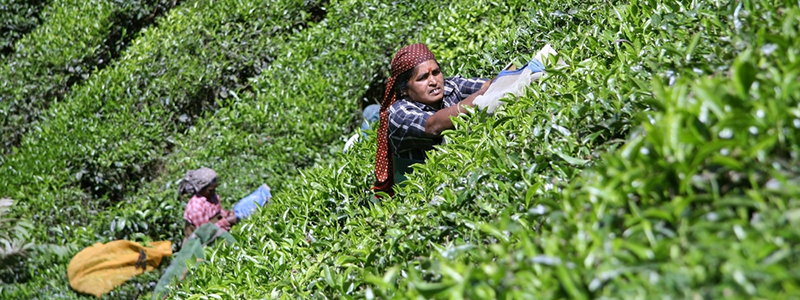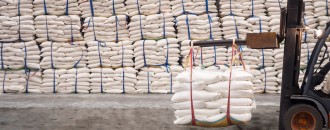
Rains affect India’s tea exports
The Dollar Business Bureau  Delayed rain fall and increased competition in the international market led to a steep fall in India’s tea exports last year. The country earned Rs 3,485 crore by exporting 180 million kg of tea during last year (April-Feb). The volume was less than 4,509 registered a year ago when India exported 225 million kgs of tea. “Volume of export of Indian tea during 2014-15 has been lower than the level registered during 2013-14 primarily on account of fall in production of Assam orthodox tea caused by delayed rains,” said Nirmala Sitharaman, Minister of State, Commerce and Industry. Other factors that contributed to the decline are increased supplies from Kenya leading to a reduced average price of US$ 2.14/kg in the international market, and fall in demand in the high-value markets such as USA, Iran and Russia, the minister said. The government’s Merchandise Exports from India Scheme is aimed at promoting exports of value-added teas with a view to gain maximum foreign exchange earnings as against the export of bulk teas, which have limited potential for branding of India tea. As per the new Foreign Trade Policy (2015-2020), notified by the Directorate General of Foreign Trade (DGFT), most of the teas in packaged or value-added form will receive reward at the rate of 5% of free on board (FOB) value for export to various destinations. Tea in bulk form including tea waste and other black tea will be eligible for reward at the rate of 3% of FOB value. The government has received a proposal from the Indian Tea Association, suggesting restoration of the reward rate for bulk tea exports from 3% to 5% of FOB value as available under the previous Foreign Trade Policy (FTP). Such representations are regularly reviewed by the government as part of updation of the FTP. The tea board also has a strategy for increasing export of Indian tea with additional focus on value-added teas. Some of the measures include the setting up value-addition infrastructure, branding and sustained promotion in key markets. India produces some of the world’s finest teas like Darjeeling Tea in West Bengal, Assam Tea in Assam, Nilgiris Tea in Tamil Nadu and Kangra Tea in Himachal Pradesh that are famous for their delicate flavour, strength and brightness. In 2014-15, Assam produced 583.36 million kg of tea, while West Bengal contributed only 324 million kg, according to a government data. The single-origin teas grown in specific states and regions of India have unique characteristics and have large potential to contribute to the generation of foreign exchange. The government always consults all tea growing states which are represented on the Tea Board while finalizing the marketing strategy. As part of the Tea Development and Promotion Scheme, tea growers also get substantial financial and technical assistance from the Tea Board for producing and marketing tea, the minister said. Besides, the Tea Board accepts proposals and applications from growers in all states and assists them in activities like rejuvenation, pruning, infilling, uprooting and replanting of old tea areas, extension planting, quality upgradation and product diversification.
Delayed rain fall and increased competition in the international market led to a steep fall in India’s tea exports last year. The country earned Rs 3,485 crore by exporting 180 million kg of tea during last year (April-Feb). The volume was less than 4,509 registered a year ago when India exported 225 million kgs of tea. “Volume of export of Indian tea during 2014-15 has been lower than the level registered during 2013-14 primarily on account of fall in production of Assam orthodox tea caused by delayed rains,” said Nirmala Sitharaman, Minister of State, Commerce and Industry. Other factors that contributed to the decline are increased supplies from Kenya leading to a reduced average price of US$ 2.14/kg in the international market, and fall in demand in the high-value markets such as USA, Iran and Russia, the minister said. The government’s Merchandise Exports from India Scheme is aimed at promoting exports of value-added teas with a view to gain maximum foreign exchange earnings as against the export of bulk teas, which have limited potential for branding of India tea. As per the new Foreign Trade Policy (2015-2020), notified by the Directorate General of Foreign Trade (DGFT), most of the teas in packaged or value-added form will receive reward at the rate of 5% of free on board (FOB) value for export to various destinations. Tea in bulk form including tea waste and other black tea will be eligible for reward at the rate of 3% of FOB value. The government has received a proposal from the Indian Tea Association, suggesting restoration of the reward rate for bulk tea exports from 3% to 5% of FOB value as available under the previous Foreign Trade Policy (FTP). Such representations are regularly reviewed by the government as part of updation of the FTP. The tea board also has a strategy for increasing export of Indian tea with additional focus on value-added teas. Some of the measures include the setting up value-addition infrastructure, branding and sustained promotion in key markets. India produces some of the world’s finest teas like Darjeeling Tea in West Bengal, Assam Tea in Assam, Nilgiris Tea in Tamil Nadu and Kangra Tea in Himachal Pradesh that are famous for their delicate flavour, strength and brightness. In 2014-15, Assam produced 583.36 million kg of tea, while West Bengal contributed only 324 million kg, according to a government data. The single-origin teas grown in specific states and regions of India have unique characteristics and have large potential to contribute to the generation of foreign exchange. The government always consults all tea growing states which are represented on the Tea Board while finalizing the marketing strategy. As part of the Tea Development and Promotion Scheme, tea growers also get substantial financial and technical assistance from the Tea Board for producing and marketing tea, the minister said. Besides, the Tea Board accepts proposals and applications from growers in all states and assists them in activities like rejuvenation, pruning, infilling, uprooting and replanting of old tea areas, extension planting, quality upgradation and product diversification.
April 30, 2015 | 8:15 pm IST.





 to success.
to success.